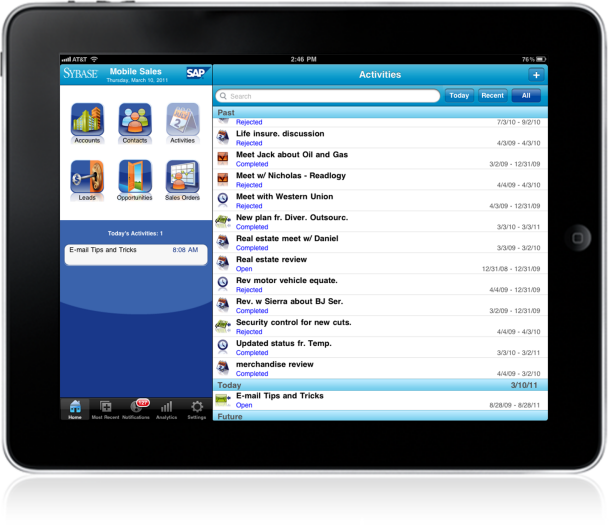The mobile enterprise app tipping point is here: Can business tech learn UI?

The interest in mobile enterprise applications was obvious at SAP Sapphire this week. In fact, it was impossible to miss the throngs of technology executives huddled around the mobility demonstrations at various booths on the conference floor. 
SAP executives---co-CEOs Bill McDermott and Jim Hagemann Snabe as well as a bevy of others---were clearly positioning for a post PC world. The enterprise terminal of the future is a tablet or smartphone. McDermott noted that he can run the company from an iPad as he showed off how Avon brings inventory data---from an SAP back-end system of course---to reps and consumers.
Meanwhile, SAP's purchase of Sybase is making more sense by the minute. Sybase brings the mobility mojo to the table. SAP brings the systems of records. Sybase's platform extends those systems to mobile devices. Toss in in-memory capabilities and analytics and it's clear SAP has an interesting story to tell. It's also a story that other enterprise application vendors may have a tough time replicating.
Indeed, SAP did its part and rolled out a bevy of mobile applications. These apps, which will be generally available in a few months, cover human resources, procurement, finance and sales. Many of these apps will be reskinned for customers. The company can now turn apps around for Android and iOS tablets in days not weeks. Research in Motion is another key partner. In the end, HTML 5 will be SAP's bridge to all devices.
Toss in deals with Accenture and it's clear that enterprise software tentacles will reach apps.
What remains to be seen is whether user interfaces will matter for the enterprise and all the vendors courting IT buyers. Among the key questions:
- Do business technology vendors have UI chops?
- Can these technology providers garner enthusiasm among workers like Angry Birds does for consumers?
- Is the power of enterprise mobility the data and analytics in the field or the UI that's so good that most users don't even notice?
- Will mobile interfaces be screwed up by customers who can’t avoid the temptation to customize like they do with enterprise apps?
- What can these business technology giants learn from the consumer market?
For instance, SAP charges for Sybase's Unwired platform. The consumer playbook would be to give that away for free, license apps for a few bucks a month and dominate the market. Can SAP go there? Should it?
I was seated in the back with Vinnie Mirchandani playing Simon Cowell and chuckling at how Microsoft's Excel and Office remains such a big UI metaphor for a lot of SAPers. If you want to get oohs and aahs out of an SAP crowd just show off real-time enterprise data being calculated in a spreadsheet. And if you can send a chart via Outlook there were UI orgasms all around.
At the Innojam powwow it was clear that UI is a work in progress. Granted, developers only had 30 hours to work on the project, but the UIs showed everything that was right and wrong with enterprise software.
The issue: Out of 12 demonstrations---all of which were designed to show off SAP's HANA's real-time in-memory analytics---only one could be construed for a user interface for the masses. That interface in a project dubbed Prajnaa was deadly simple---it was a simple box. That box could crunch anything you wanted about the company in real-time and serve up whatever you searched for. There were no clunky reports and no set views.
Of course the developers behind the Prajnaa demonstration---Ganesh Vaitheeswaran and Arindam Bhattacharjee--had to show how easy it was to send data from the application via Outlook, but other than that it was clearly the winner of the night.
Prajnaa's demo abstract looked like this:
Prajnaa provides a Google-like “One- click, Search-to-BI” experience where the user “Discovers” and “Understands” the data space instead of just navigating through it. Users submit a search query and get “information blocks” that display the matching data and analyzed insights using best-practices visualization. The in-memory, columnar store in HANA is used to analyze and aggregate huge amounts of data and provide ultra-fast results.
That Prajnaa could be used on any device. During another presentation one observer remarked that "you shouldn't be able to see code" during the demonstration. That's UI rule No. 1 kids. However, if enterprise vendors get this UI thing mastered the data these software applications control will be the big differentiator. The idea is to get workers the data and analytics they need quickly and in an interface that fades away.
On the mobile front, enterprise software has a great crutch. Apple's iOS provides templates to make the UI consistent. In other words, enterprise vendors can only screw up so much. SAP's Ian Kimbell, a vice president better known as "demo boy," said that mobile apps are focused on a business need. Suites are deconstructed into shopping carts, travel approvals and sales goals. Each business need will get an app by role including an oil and gas company taking tank inventories, maintenance history and reporting them via a tablet.
"We can churn apps out quickly and let the customer decide what adds business value," said Kimbell. SAP will have 40 to 50 mobile apps and some customers---such as four hospitals using an electronic medical record app---are trialing them already. “We have a standard look and feel for our apps,” said Kimbell.
For enterprise software, a UI that's simplistic and barely noticed will be a sea change. Here's to hoping we get there.